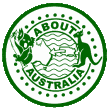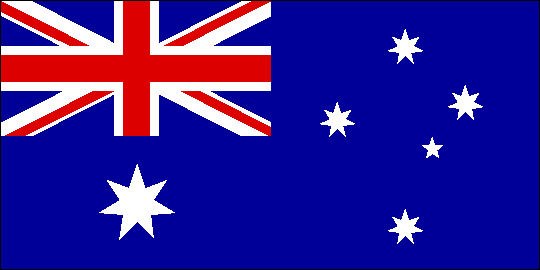
About Australia
Australian Foods, Gifts and Souvenirs
401 Isom Rd, Suite 500, San Antonio, Texas, 78216, USA
Phone 210-299-1077, Fax 210-541-6755
www.about-australia-shop.com
AUSTRALIAN FLAG

Flag of Australia
Buy Flags and other Australian Goods (Click Here)
THE ORIGINS OF OUR FLAG
|
The first thing that you notice about the Australian
flag is the presence of the Union Jack (the British flag) in it's top
left-hand corner. This is of course due to Australia being a monarchy,
under Great Britain (our monarch being Queen Elizabeth II). Our national
flag, or ensign, was officially recognised following the Flags Act of
1953, even though the design you see here (above) has existed since 1903.
The seven-pointed star underneath the Union Jack symbolises the
Commonwealth of Australia, which is made up of the six Australian states
(New South Wales, Victoria, Queensland, South Australia, Western Australia
and Tasmania), each represented by one point of this star, and the last
point of the star represents our two territories: Australian Capital
Territory, and Northern Territory. The five stars on the right half of our
ensign may look familiar, they make up the star constellation Crux, also
known as the Southern Cross. This constellation played an important role
in the navigation of the very ships that first arrived in Australia.
|
MODERN ISSUES OF OUR FLAG
|
For years there has been debate, with strong feelings
on either side, that Australia should no longer be a monarchy under Great
Britain, but become a Republic where our Head of State is elected directly
by the people on the basis of merit, as opposed to birthright, as is the
case with Queen Elizabeth II today. This dispute has sparked another
issue, regarding the Union Jack's presence on our national flag.
Monarchists believe that our ensign should not be altered and that we
should also remain a monarchy under Great Britain, whereas republicans
would like to see a new Australian flag without the Union Jack on it, and
separate our political system from Great Britain's. A referendum was held
in November of 1999, asking the Australian people to vote on becoming a
republic or remaining a constitutional monarchy, which some argue is no
longer relevant in a modern democracy. Today, we remain a constitutional
monarchy of Great Britain.
|
Buy Flags and other Australian Goods (Click Here)
Privacy Policy

About Australia
Australian Foods, Gifts and Souvenirs
401 Isom Rd, Suite 500, San Antonio, Texas, 78216, USA
Phone 210-299-1077, Fax 210-541-6755
www.about-australia-shop.com